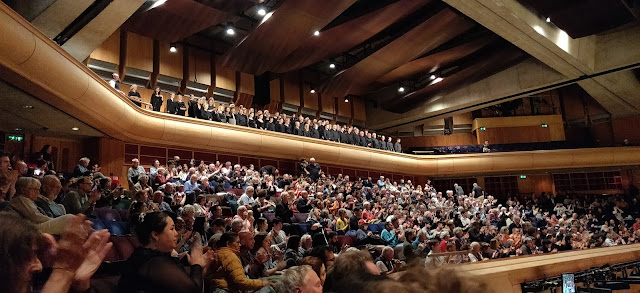Sunday 5th June 2022, Barbican Hall, London
Eric Greene (prisoner) Ángeles Blancas Gulín (mother) Stefano Secco (Gaoler / Grand Inquisitor) Egor Zhuravskii (First Priest) Chuma Sijeqa (Second Priest) London Symphony Chorus and Guildhall School Singers, dir. Simon Halsey, London Symphony Orchestra, cond. Antonio Pappano
LSO Chorus taking applause for 'Il Prigioniero' at the Barbican. Photograph by David Glynn
Taking place on the last day of a Platinum Jubilee weekend that engulfed the nation in a sea of flags and sentimental patriotism, Antonio Pappano and the London Symphony Orchestra’s concert performance of Luigi Dallapiccola’s one-act opera Il Prigioniero (1944-48) opened with an unscheduled performance of the National Anthem, for which audience members stood up enthusiastically. There was a marked—though surely unintentional—irony to this, given that Dallapiccola’s work is a rigorous challenge to persisting forms of authoritarianism-by-consent. The first half of the concert offered Ottorino Respighi’s Church Windows: an orchestral showpiece, supposedly evocative of medieval stained glass, which offered of familiar orchestral colours, tonal resolution, and a comforting vision of religious and musical order. By contrast, Dallapiccola’s twelve-tone opera, written from within Fascist Italy, operated as a gigantic question mark.
Under the Austro-Hungarian empire, Dallapiccola's family had been suspected of Italian nationalism, and he had himself been forcibly relocated and placed in a kind of open confinement in the city of Graz as an adolescent. Coming to public prominence as a composer in the thirties, he had initially supported Mussolini’s regime until the Race Laws of 1938 threatened his wife, the librarian Laura Coen Luzzatto, of Jewish heritage, and Il Prigioniero is an opera about being coerced and seduced into desiring one's own own unfreedom, even one's own death. The libretto, Dallapiccola's own, is based on Auguste Villiers de l’Isle-Adam's short story ‘Torture by Hope’: Laura had discovered it on a trip to Paris on the eve of war. In the dungeons of the Inquisition, a Prisoner is offered hope by his gaoler’s reports of a rebellion in Flanders; creeping through an open cell door, he begins his escape, only to be greeted at journey’s end by the Grand Inquisitor, who leads him to the stake as the prisoner whispers “La Libertà”, “Freedom?” Dallapiccola sets this deceptively simple scenario as something like a chamber opera, with the music characterised by pounding drama and flowing (serial) melody alike. It’s a delicate balance, and the singers—particularly the American tenor Eric Greene as the Prisoner—gave a strong, moving account of the music, not overplaying its melodrama, while Pappano, conducting without a baton, swept his whole body convulsively up and down in rhythmic sympathy. Constructed in a single, unbroken span, the opera is guided by motifs constructed from tone rows which serve, not as recurrences of fixed ideas of character or fate, static tokens of being, but as ideas in contestation and--ultimately--ideals betrayed: Hope, Prayer, Freedom, Brotherhood. Dallapiccola’s coup-de-theatre is the presence of an off-stage choir, or “inner chorus”, who sing verses from the Psalms in Latin, giving collective form to the prisoner’s individual hope. Yet at the climax, a second chorus moves onstage, the internal voice of individual freedom merging with the external forms of religious conformity singing the condemned to the stake. Despite this bitter irony, Dallapiccola’s ending can be read as act of existentialist defiance. Moving from music back into speech, the pirsoner's final, spoken whisper of “freedom?”, offers up, not so much an acceptance of his fate, as a response to false liberal or pietistic hope—the kind of hope heard in the National Anthem with which the concert began. This response, Dallapiccola suggests, can only be a question, not an answer. Today, the prison cell is still our reality. The Dungeons of Zaragoza end in Guantanamo Bay and in Abu Ghraib; in the immigration “detention centres” that spring up in the bucolic countryside National Anthem-singing patriots so love to celebrate. (Lest we forget, concentration camps are a British invention.) Il Prigioniero speaks more than ever, within and against the contexts in which it is placed. The question, as yet unanswered, is still: “Freedom?”



No comments:
Post a Comment